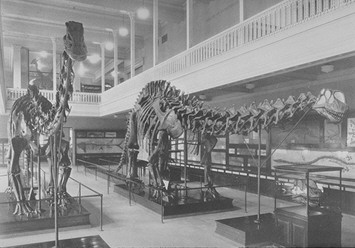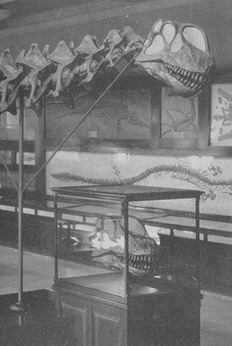41a. The Carnegie Apatosaurus Mount, 1936
 The
photograph at the right shows Apatosaurus lousiae as it was mounted
in the Carnegie Museum in Pittsburgh (Apatosaurus is on the right,
the famous Carnegie
Diplodocus is at the left). If you look closely, or better yet,
if you look at the enlarged detail below, you will see that
Apatosaurus has two heads, one mounted on the neck, and one in a
case below. The one on the skeleton is in fact a cast of the one in the
case, and it is a cast because Charles Gilmore was not at all sure that it
belonged on the skeleton. The man who supervised the reconstruction,
William J. Holland, was not sure either. In fact, Holland leaned toward a
Diplodocus-like skull that had been found in the Carnegie quarry,
rather than the Camarasaurus-like skull that the American Museum in
New York, and the Peabody Museum in New Haven, had installed on their
skeletons.
The
photograph at the right shows Apatosaurus lousiae as it was mounted
in the Carnegie Museum in Pittsburgh (Apatosaurus is on the right,
the famous Carnegie
Diplodocus is at the left). If you look closely, or better yet,
if you look at the enlarged detail below, you will see that
Apatosaurus has two heads, one mounted on the neck, and one in a
case below. The one on the skeleton is in fact a cast of the one in the
case, and it is a cast because Charles Gilmore was not at all sure that it
belonged on the skeleton. The man who supervised the reconstruction,
William J. Holland, was not sure either. In fact, Holland leaned toward a
Diplodocus-like skull that had been found in the Carnegie quarry,
rather than the Camarasaurus-like skull that the American Museum in
New York, and the Peabody Museum in New Haven, had installed on their
skeletons.  Holland
had written a paper in 1915 in which he gave good reasons why the
Diplodocus-like skull should be preferred. But he never mounted
that skull on the skeleton; he either lacked the courage of his
convictions, or he was not allowed to install the skull of his choice. So
the Carnegie Apatosaurus stood for twenty years without a skull,
until finally a cast of the conventional Camarasaurus-like skull
was put in place.
Holland
had written a paper in 1915 in which he gave good reasons why the
Diplodocus-like skull should be preferred. But he never mounted
that skull on the skeleton; he either lacked the courage of his
convictions, or he was not allowed to install the skull of his choice. So
the Carnegie Apatosaurus stood for twenty years without a skull,
until finally a cast of the conventional Camarasaurus-like skull
was put in place.
As it turns out, of course, Holland was right, and the wrong skull had
been installed. The situation was not corrected until the
1980s.
 Source:
Source:Gilmore, Charles W. "Osteology of Apatosaurus, with special reference to specimens in the Carnegie Museum," in: Memoirs of the Carnegie Museum, vol. 11, no. 4 (1936), pp. 175-300. This work is on display as exhibit item 41.


 ®Linda Hall Library
®Linda Hall Library5109 Cherry Street
Kansas City, MO 64110
Please direct comments to ashwortb@lhl.lib.mo.us